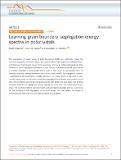| dc.contributor.author | Wagih, Malik | |
| dc.contributor.author | Larsen, Peter M | |
| dc.contributor.author | Schuh, Christopher A | |
| dc.date.accessioned | 2022-05-19T12:46:20Z | |
| dc.date.available | 2022-05-19T12:46:20Z | |
| dc.date.issued | 2020 | |
| dc.identifier.uri | https://hdl.handle.net/1721.1/142602 | |
| dc.description.abstract | The segregation of solute atoms at grain boundaries (GBs) can profoundly impact the structural properties of metallic alloys, and induce effects that range from strengthening to embrittlement. And, though known to be anisotropic, there is a limited understanding of the variation of solute segregation tendencies across the full, multidimensional GB space, which is critically important in polycrystals where much of that space is represented. Here we develop a machine learning framework that can accurately predict the segregation tendency—quantified by the segregation enthalpy spectrum—of solute atoms at GB sites in polycrystals, based solely on the undecorated (pre-segregation) local atomic environment of such sites. We proceed to use the learning framework to scan across the alloy space, and build an extensive database of segregation energy spectra for more than 250 metal-based binary alloys. The resulting machine learning models and segregation database are key to unlocking the full potential of GB segregation as an alloy design tool, and enable the design of microstructures that maximize the useful impacts of segregation. | en_US |
| dc.language.iso | en | |
| dc.publisher | Springer Science and Business Media LLC | en_US |
| dc.relation.isversionof | 10.1038/S41467-020-20083-6 | en_US |
| dc.rights | Creative Commons Attribution 4.0 International License | en_US |
| dc.rights.uri | https://creativecommons.org/licenses/by/4.0 | en_US |
| dc.source | Nature | en_US |
| dc.title | Learning grain boundary segregation energy spectra in polycrystals | en_US |
| dc.type | Article | en_US |
| dc.identifier.citation | Wagih, Malik, Larsen, Peter M and Schuh, Christopher A. 2020. "Learning grain boundary segregation energy spectra in polycrystals." Nature Communications, 11 (1). | |
| dc.contributor.department | Massachusetts Institute of Technology. Department of Nuclear Science and Engineering | |
| dc.contributor.department | Massachusetts Institute of Technology. Department of Materials Science and Engineering | |
| dc.relation.journal | Nature Communications | en_US |
| dc.eprint.version | Final published version | en_US |
| dc.type.uri | http://purl.org/eprint/type/JournalArticle | en_US |
| eprint.status | http://purl.org/eprint/status/PeerReviewed | en_US |
| dc.date.updated | 2022-05-19T12:42:55Z | |
| dspace.orderedauthors | Wagih, M; Larsen, PM; Schuh, CA | en_US |
| dspace.date.submission | 2022-05-19T12:42:56Z | |
| mit.journal.volume | 11 | en_US |
| mit.journal.issue | 1 | en_US |
| mit.license | PUBLISHER_CC | |
| mit.metadata.status | Authority Work and Publication Information Needed | en_US |
